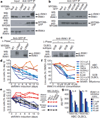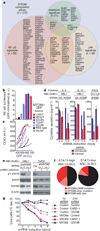Oncogenically active MYD88 mutations in human lymphoma
- PMID: 21179087
- PMCID: PMC5024568
- DOI: 10.1038/nature09671
Oncogenically active MYD88 mutations in human lymphoma
Abstract
The activated B-cell-like (ABC) subtype of diffuse large B-cell lymphoma (DLBCL) remains the least curable form of this malignancy despite recent advances in therapy. Constitutive nuclear factor (NF)-κB and JAK kinase signalling promotes malignant cell survival in these lymphomas, but the genetic basis for this signalling is incompletely understood. Here we describe the dependence of ABC DLBCLs on MYD88, an adaptor protein that mediates toll and interleukin (IL)-1 receptor signalling, and the discovery of highly recurrent oncogenic mutations affecting MYD88 in ABC DLBCL tumours. RNA interference screening revealed that MYD88 and the associated kinases IRAK1 and IRAK4 are essential for ABC DLBCL survival. High-throughput RNA resequencing uncovered MYD88 mutations in ABC DLBCL lines. Notably, 29% of ABC DLBCL tumours harboured the same amino acid substitution, L265P, in the MYD88 Toll/IL-1 receptor (TIR) domain at an evolutionarily invariant residue in its hydrophobic core. This mutation was rare or absent in other DLBCL subtypes and Burkitt's lymphoma, but was observed in 9% of mucosa-associated lymphoid tissue lymphomas. At a lower frequency, additional mutations were observed in the MYD88 TIR domain, occurring in both the ABC and germinal centre B-cell-like (GCB) DLBCL subtypes. Survival of ABC DLBCL cells bearing the L265P mutation was sustained by the mutant but not the wild-type MYD88 isoform, demonstrating that L265P is a gain-of-function driver mutation. The L265P mutant promoted cell survival by spontaneously assembling a protein complex containing IRAK1 and IRAK4, leading to IRAK4 kinase activity, IRAK1 phosphorylation, NF-κB signalling, JAK kinase activation of STAT3, and secretion of IL-6, IL-10 and interferon-β. Hence, the MYD88 signalling pathway is integral to the pathogenesis of ABC DLBCL, supporting the development of inhibitors of IRAK4 kinase and other components of this pathway for the treatment of tumours bearing oncogenic MYD88 mutations.
Figures




Similar articles
-
A multiprotein supercomplex controlling oncogenic signalling in lymphoma.Nature. 2018 Aug;560(7718):387-391. doi: 10.1038/s41586-018-0290-0. Epub 2018 Jun 20. Nature. 2018. PMID: 29925955 Free PMC article.
-
Selective interleukin-1 receptor-associated kinase 4 inhibitors for the treatment of autoimmune disorders and lymphoid malignancy.J Exp Med. 2015 Dec 14;212(13):2189-201. doi: 10.1084/jem.20151074. Epub 2015 Nov 30. J Exp Med. 2015. PMID: 26621451 Free PMC article.
-
Biological and Clinical Relevance of Associated Genomic Alterations in MYD88 L265P and non-L265P-Mutated Diffuse Large B-Cell Lymphoma: Analysis of 361 Cases.Clin Cancer Res. 2017 May 1;23(9):2232-2244. doi: 10.1158/1078-0432.CCR-16-1922. Epub 2016 Dec 6. Clin Cancer Res. 2017. PMID: 27923841
-
Molecular Pathogenesis of Diffuse Large B-Cell Lymphoma.J Clin Exp Hematop. 2016;56(2):71-78. doi: 10.3960/jslrt.56.71. J Clin Exp Hematop. 2016. PMID: 27980305 Free PMC article. Review.
-
Rewired NFκB signaling as a potentially actionable feature of activated B-cell-like diffuse large B-cell lymphoma.Eur J Haematol. 2016 Dec;97(6):499-510. doi: 10.1111/ejh.12792. Epub 2016 Sep 8. Eur J Haematol. 2016. PMID: 27526684 Review.
Cited by
-
Molecular and genomic aberrations in Chlamydophila psittaci negative ocular adnexal marginal zone lymphomas.Am J Hematol. 2013 Sep;88(9):730-5. doi: 10.1002/ajh.23490. Epub 2013 Jul 23. Am J Hematol. 2013. PMID: 23720088 Free PMC article.
-
A20 haploinsufficiency disturbs immune homeostasis and drives the transformation of lymphocytes with permissive antigen receptors.Sci Adv. 2024 Aug 23;10(34):eadl3975. doi: 10.1126/sciadv.adl3975. Epub 2024 Aug 21. Sci Adv. 2024. PMID: 39167656 Free PMC article.
-
Cancer biology functional genomics: From small RNAs to big dreams.Mol Carcinog. 2020 Dec;59(12):1343-1361. doi: 10.1002/mc.23260. Epub 2020 Oct 12. Mol Carcinog. 2020. PMID: 33043516 Free PMC article.
-
Chidamide induces apoptosis in DLBCL cells by suppressing the HDACs/STAT3/Bcl‑2 pathway.Mol Med Rep. 2021 May;23(5):308. doi: 10.3892/mmr.2021.11947. Epub 2021 Mar 2. Mol Med Rep. 2021. PMID: 33649847 Free PMC article.
-
Evolution and impact of subclonal mutations in chronic lymphocytic leukemia.Cell. 2013 Feb 14;152(4):714-26. doi: 10.1016/j.cell.2013.01.019. Cell. 2013. PMID: 23415222 Free PMC article.
References
Publication types
MeSH terms
Substances
Grants and funding
LinkOut - more resources
Full Text Sources
Other Literature Sources
Medical
Molecular Biology Databases
Research Materials
Miscellaneous

